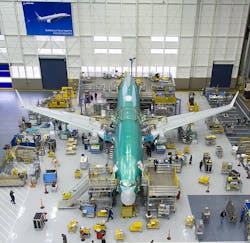Maximizing aerospace & defense supply-chain integration
By Aaron Continelli, president of Cre8tive Technology & Design
The manufacturing process within the aerospace and defense (A&D) industry is essentially a linear chain, with a supplier of raw materials on one end and the customer on the other. In between is a series of steps involving manufacturers and shippers, each with their own responsibilities, deadlines, and challenges. The supply chain is dependent on the efficiency of each step within it. The supply chain is also fragile – one delay can have a ripple effect on everything downstream.
The supply chain is also fragile – one delay can have a ripple effect on everything downstream. High-profile disasters, such as those with the Boeing 787 Dreamliner andAirbus A350 XWB, highlight how inefficient supply chains can result in unreliable part orders, delay product releases, and even damage brand faith. These losses are entirely preventable. They can be minimized or avoided by improving the integration and visibility of the entire supply chain. Fortunately, the chain provides manufacturers with many ways to do this.
Redefining supplier relationships
The traditional relationship between supplier and original equipment manufacturer (OEM) has gone through significant changes, and understanding these changing dynamics is essential to maximizing integration of the supply chain. Previously, OEMs were responsible for managing all their suppliers – sometimes thousands at once. Today, OEMs deal with major Tier 1 suppliers, which provideOEMs with the final parts needed to build aircraft. These suppliers work with Tier 2 suppliers, who in turn work with Tier 3 suppliers. The process that once involved managing thousands of relationships has become considerably more streamlined.
On the one hand, this new structure helps streamline communications down the supply chain. Yet, OEMs also have less visibility into the actions of Tier 2 and Tier 3 suppliers. This offers a tremendous opportunity for Tier 1 suppliers to act as more than an intermediary. Given their knowledge and experience, Tier 1 suppliers should take on the role of a helpful partner.
OEMs should feel comfortable sharing their strategic and financial goals (or KPIs) with their Tier 1 suppliers. In turn, Tier 1 suppliers can give advice on improving design and operations while ensuring the OEM gets the right parts. After all, Tier 1 suppliers are the ones managing supplier relationships. They can advise on which lower-tier suppliers are best for the job, which is especially important with customized orders or new aircraft.
In this relationship, both parties benefit. The OEM is more likely to hit their goals, while the Tier 1 supplier ensures they have a satisfied customer. The line is unbroken.
Improving procurement
Supplier-OEM isn’t the only relationship that needs to be redefined within the supply chain. While A&D often focuses on the design, engineering, and manufacturing of equipment, the industry should also focus on improving the procurement process. The rising costs of raw materials, along with shrinking margins, make efficiency within this early supply chain stage all the more important.
This requires a shift in the role procurement plays in the manufacturing process. Rather than acting as a function within the supply chain, procurement shouldadopt a service-oriented mindset. How can procurement provide the best experience for its customers? How can it ensure parts and supplies will be compatible with the product under development?
Procurement can answer these questions by bringing together people from across the supply chain to discuss needs and challenges that will lead to greater efficiency and help leverage purchasing power. For example, by knowing the end customer’s current and future needs, suppliers could get to work earlier to obtain materials that are scarce or subject to market volatility. In the end, procurement becomes a center of innovation and collaboration while benefiting every stage of the supply chain.
Getting agile
No matter the strength of the relationships throughout the supply chain, the reality is that disruptions happen. Today’s world of customized orders, technological reliance, and volatility make these interruptions even more likely. These can have a huge impact on the A&D supply chain, where small delays can add up.
Fortunately, the industry can leverage today’s technology to handle these disruptions. Agile management systems use algorithms that allow operations managers to make the right operational decisions at a moment’s notice. Keep in mind that these algorithms aren’t meant to replace managers. Algorithms only provide information and options – the ultimate decision rests with the manager.
Meanwhile, radio-frequency identification (RFID) tags can monitor the transportation conditions of the packages in which they’re placed. Predictive analytics programs can analyze big data for risk management. Enterprise resource planning (ERP) systems allow companies a bird’s-eye view across departments in a centralized location for easy visibility and tracking. All of these things offer new benefits, and increased supply chain visibility is just one of them.
Benefits of integration
Addressing the above points can reduce many of the issues facing the A&D industry today. Specifically, better supply chain integration will allow manufacturers to:
● Improve part planning: With better visibility across the supply chain, companies will be better able to plan out orders and stick to schedules. OEMs can consider material scarcity and market prices when ordering parts. Suppliers can offer their own insights into future conditions, which may prompt OEMs to order future parts now to avoid delays in the future.
● Plan for unexpected events: Visibility makes it easier for companies to plan for unexpected events. For example, knowledge of last-minute supplier delays allows OEMs to shift schedules rather than wait for parts that won’t arrive.
● Track an order along the supply chain: All suppliers and OEMs should understand the status of every order as it moves along the supply chain. Otherwise, damages will go unnoticed until they arrive at the next destination. This makes it harder to find the root of the problem and prevent it next time.
● Improve recordkeeping: Integration forces workers to record activities electronically, eliminating the paper-and-pencil processes upon which many parties still rely.
The stakes for the A&D industry
Internal and external factors are reshaping A&D like never before. Adapting to these new conditions is vital, though there are always arguments for maintaining the status quo. Perhaps leaders feel their internal processes are working and there’s no need for change. Maybe the idea of turning over control to suppliers is scary.
The benefits of increased visibility can easily outweigh the risks. If the latest high-profile cases have shown us anything, it’s that visibility is a valuable tool for ensuring large-scale projects are done on time and with fewer hiccups. Supply chains in A&D are fragile and complex, and leaders should jump at the chance of making things easier for their works and themselves. Visibility is a step in the right direction.
Aaron Continelli, president of Cre8tive Technology & Design, started things small in 2005. What began as a one person consulting firm has now become a staff of 58 with three office locations. Specializing in ERP system sales and services, Cre8tive Technology and Design became an EPICOR Partner (Value Added Reseller) in 2007. Since then, Cre8tive Technology and Design has emerged as one of EPICOR’s ELITE and won the 2013 and 2015 Americas Partner of the Year as the Top Revenue Producer.
Search the Aerospace & Defense Buyer's Guide
The go-to resource for Intelligent Aerospace technology news & information:
Covering key topics
Across all market segments
Subscribe to the free Intelligent Inbox e-newsletter
Subscribe to receive all the latest aerospace technology news & information, delivered directly to your e-mail inbox twice a week (Tuesdays and Thursdays). Sign upfor your free subscription to the Intelligent Inbox e-newsletter at http://www.intelligent-aerospace.com/subscribe.html.
Connect on social media
Keep pace with aerospace innovation and opportunities via your favorite social media channels. Connect with Intelligent Aerospace on Twitter (@IntelligentAero), LinkedIn,Google+, and Instagram.




